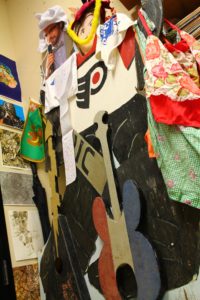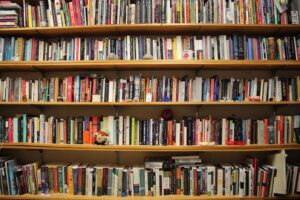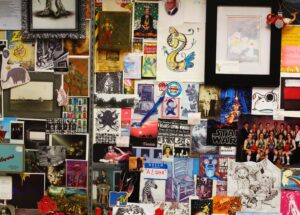Portrait of the Writing Space as a Barn
Writing Spaces
I grew up in a barn, a creaky lug of a building almost a century old and sided with rust-streaked tin. To understand the composition and function of my writing space, my office, you need to understand my family’s barn; jotting down notes to compose this reflection, I have realized how much our barn shaped the space in which I work and write.
Our barn was like a dusty soup of sediment that never hardened into separate strata, the artefacts of different generations preserved and stirred together with the building’s fluid functions. Our barn was a museum in which you could grip the dust-greased remnants of decades past: the blacksmith hammer, the banged up Players Tobacco tins, the boxes of issues of LIFE. Our barn was a zoo that housed up to twenty cats, just as many pigeons, and a handful of wilder critters. It was a playground in which you pretended to lose your life in a variation on tag we called “Zombie” or in which you put your life on the line for real playing basketball in the loft, a ten-foot drop into an ancient buggy looming where the three-point line should have arced. Our barn was a workshop, too; we kids helped when needed, but mostly, while dad and grandpa laboured, we constructed wooden toys, sliver-giving guns or barely pond-worthy boats for G.I. Joes.
 My office is like our barn, similarly layered and swirling with different identities and items. It is characterized by a blend of uses: HQ for my university work (prepping, grading, emailing, etc.); a meeting place for one-on-ones, the creative writing group, my smaller classes; and a space for me to hunker down and write. My office is also packed with objects from all phases of my life: books, posters, mementos, curio, cards, and gifts, this heap fittingly ornamented with items previously stored in our barn—my Ron Hextall carnival cut-out and Billy Ocean air guitar.
My office is like our barn, similarly layered and swirling with different identities and items. It is characterized by a blend of uses: HQ for my university work (prepping, grading, emailing, etc.); a meeting place for one-on-ones, the creative writing group, my smaller classes; and a space for me to hunker down and write. My office is also packed with objects from all phases of my life: books, posters, mementos, curio, cards, and gifts, this heap fittingly ornamented with items previously stored in our barn—my Ron Hextall carnival cut-out and Billy Ocean air guitar.
As a writer, I thrive in this accumulation and clutter. This surrounding fullness, this visual busyness, produces in me a sense of calm, a sort of empty openness. This experience is comparable to when an elementary school science teacher spins the colour-filled wheel to—like magic—produce a hypnotizing blank. On the flipside, when I am stuck, I can almost always find inspiration by paging through an art book or poetry collection or by glancing around my office or by staring at my collage wall and spacing out.
 As a writer, I also value the fact that my office is a multi-use space. I think this is the case because my default state is self-scribed isolation, loathing, and shame, some terrible stream of my being always keen to toss me over, drag me under. The other work that happens in my office is part balloon and part anchor, at once lifting me up to and grounding me in a stable and sustaining community.
As a writer, I also value the fact that my office is a multi-use space. I think this is the case because my default state is self-scribed isolation, loathing, and shame, some terrible stream of my being always keen to toss me over, drag me under. The other work that happens in my office is part balloon and part anchor, at once lifting me up to and grounding me in a stable and sustaining community.
 My collage wall is the most visible manifestation of this, filled as it is with images, cards, drawings, and mementos from students, family, and friends. When I need help, taking in this wall feels the same as giving myself over to a trusted and supporting embrace. Through these artefacts, these lives materialize, manifesting memories and the endurance of our connections; and, in a way, I experience these memories and connections—the presence of these wonderful lives that have made and make and will continue to craft—as a sort of barn in which my best self is preserved and spurred to create.
My collage wall is the most visible manifestation of this, filled as it is with images, cards, drawings, and mementos from students, family, and friends. When I need help, taking in this wall feels the same as giving myself over to a trusted and supporting embrace. Through these artefacts, these lives materialize, manifesting memories and the endurance of our connections; and, in a way, I experience these memories and connections—the presence of these wonderful lives that have made and make and will continue to craft—as a sort of barn in which my best self is preserved and spurred to create.
Photos provided by Daniel Scott Tysdal

